
HYPOTHENAR WHORL - Mount of moon whorls: dermatoglyphics, Down syndrome & autism!

OCTOBER 11, 2009
The Mystery of a 'Mount of Moon Whorl' unveiled!
While the classic palmistry literature describes that the 'hypothenar whorl' (a.k.a. 'whorl on mount of Moon') can be recognized as a sign for finding a 'highly imaginative person', various scientific studies have indicated that dermatoglyphic whorls on the mount of moon are linked with Down's syndrome + a few other medical problems.
This article presents an overview of studies and theories on 'hypothenar whorl' related dermatoglyphics and ... a brand new (impressive) finding on hand characteristics in autism!
AUTHOR: Martijn van Mensvoort
INCLUDING:
• 1 - HOW TO RECOGNIZE A FINGERPRINT 'WHORL'?
• 2 - HOW TO RECOGNIZE THE 'HYPOTHENAR WHORL'?
• 3 - THE 'HYPOTHENAR WHORL' - A COMMON FEATURE IN THE HAND OF PRIMATES!
• 4 - THE 'HYPOTHENAR WHORL' - A FEATURE OF THE DOWN SYNDROME DERMATOGRAM
• 5 - THE 'HYPOTHENAR WHORL' - ASSOCIATIONS WITH OTHER MEDICAL PROBLEMS
• 6 - NEW RESEARCH: 'HYPOTHENAR WHORLS' & AUTISM!
• 7 - THE 'HYPOTHENAR WHORL' IN MODERN PALM READING (PALMISTRY)
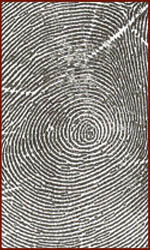
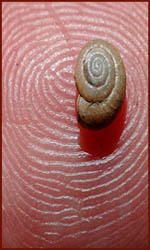
The 'whorl on the mount of Moon' (a.k.a. the hypothenar whorl) is known as one of the mysterious characteristics that can only sometimes be found in the human hand.
In 1943 Cummins & Midlo reported in their famous 'Finger Prints, Palms & Soles' statistics for a sample of 1281 German males. They found the 'true whorl' on the hypothenar in 0.7% of right hands and 0.5% of left hands (when 'spirals' and 'whorls with double-looped centers' are also included the percentages are higher: 3.1% in right hands, 1.7% in left hands).
Few other reports appear to be available for large populations - fingerprint hand analyst Richard Unger reports on his website: "The Hypothenar Eminence has Whorls in only 6 cases per thousand".
Before describing the various human characteristics that are linked with the 'whorl on the mount of Moon', this article will continue with a short introduction on the basic characteristics of fingerprint 'whorl'.
1 - HOW TO RECOGNIZE A FINGERPRINT 'WHORL'?

Sir Francis Galton.
In 1892, Sir Francis Galton published his highly influential book, 'Finger Prints' in which he described his classification system based on the number of triradii. Galton's fingerprint system included the three major patterns of fingerprint types:
The 'arch' (arches have no triradii), the 'loop' (loops have 1 triradius), and the 'whorl' (whorls have 2 triradii): see the 3th example on the right. The 'whorl' is characterised by a pattern of concentric circles, or a spiral shape - some of the ridges make a turn through at least one circuit.
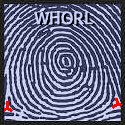
A fingerprint 'whorl'.
An additional characteristic of the 'whorl' is the presence of 2 triradii (or 'deltas') - when an imaginary line is drawn at least one recurving ridge within the inner pattern area is cut or touched.
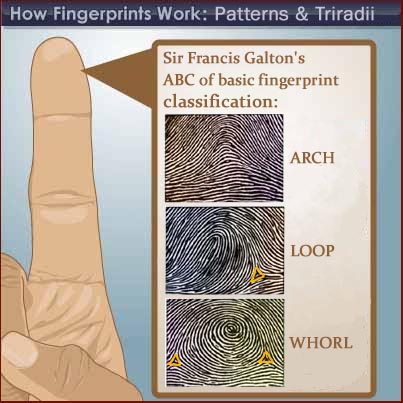
Sir Francis Galton described 3 types of fingerprints, the 'arch', 'loop' and 'whorl'.
In the modern science of fingerprint classification Galton's 3 fingerprint types are divided into 8 sub-classes (including 4 types of 'whorls'):
I - ARCH:
a. Plain arch; b. Tented arch;
II - LOOP:
a. Ulnar loop; b. Radial loop;
III - WHORL:
a. Plain whorl; b. Central pocket loop; c. Double loop; d. Accidental whorl.
NOTICE: More details on each fingerprint sub-class are presented in picture on the right - 'click' to see larger version!!
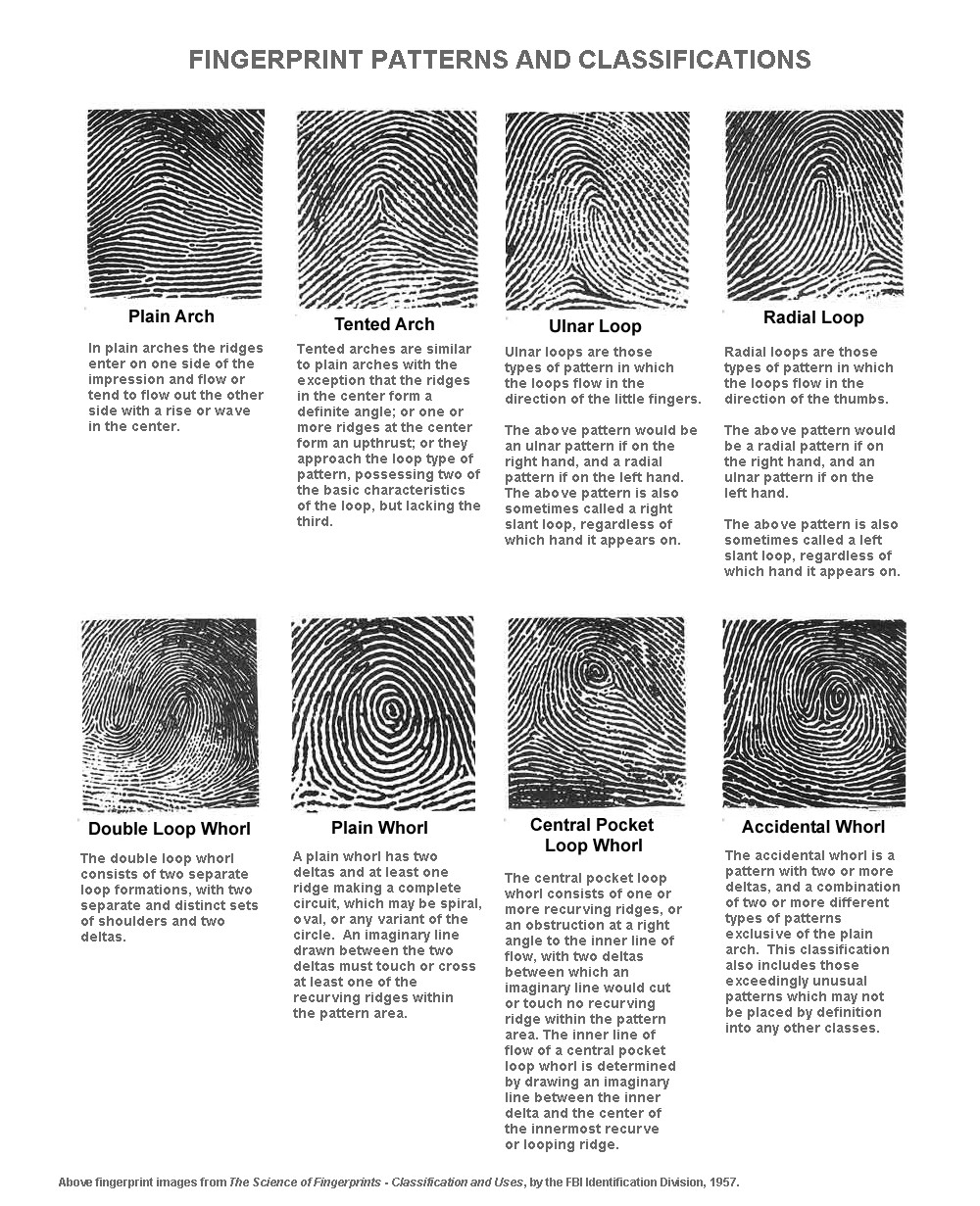
8 Sub-types of fingerprint classification.
2 - HOW TO RECOGNIZE THE 'HYPOTHENAR WHORL'?
The word 'hypothenar' refers to the prominent part of the palm of the hand above the base of the little finger - but below the 'upper transverse crease' (in palmistry: 'the heart line'); anatomically the 'hypothenar' relates to a group of three muscles of the palm that control the motion of the little finger.
In the dermatoglyphics of the 'hypothenar' is usually a triradius (t) present positioned close to the wrist.
The presence of a 'whorl' on the hypothenar (in palmistry: 'the mount of moon') is usually featured with an extra triradius (t" - see right picture below) that is positioned close to the center of the palm.
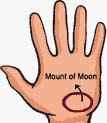
Mount of moon ('hypothenar').
Usually an additional triradius (t' - see left picture below) is found positioned near the side of the palm (or at the side of palm!). So, formally a 'hypothenar whorl' is featured with 3 triradii in the dermatoglyphics of the 'hypothenar'.
The 'whorl' example below concerns a classic 'hypothenar whorl' (W) - which is recognized by the presence of concentric circles in the dermatoglyphics.
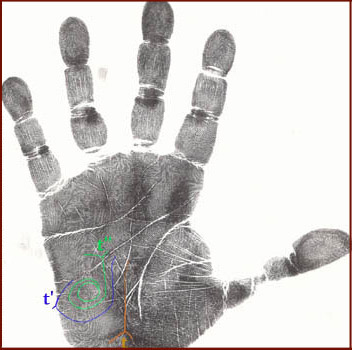
Example of a 'whorl' on the hypothenar (in palmistry: 'the mount of moon').
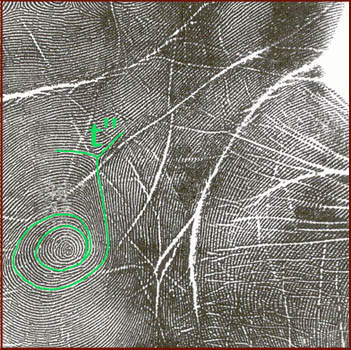
Zoom in of the 'whorl' on the hypothenar example - featured with a triradius (t") close to the center of the palm.
In the earlier mentioned work 'Finger prints, palms & soles', Cummins & Midlo also presented a classification system for the most common types of configurations in the hypothenar dermatoglyphics: see the pictures below.
The left picture presents the most common variations of the basic types: whorl, loop, tented arch and arch (including 3 types of 'hypothenar whorls').
And the right picture present some additional variations; most of these concern combinations of the basic types (including 3 additional types of 'hypothenar whorls').
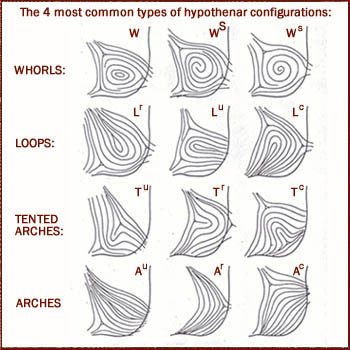
Dermatoglyphic hypothenar configurations - based on the 4 basic types: whorl, loop, tented arch & arch.
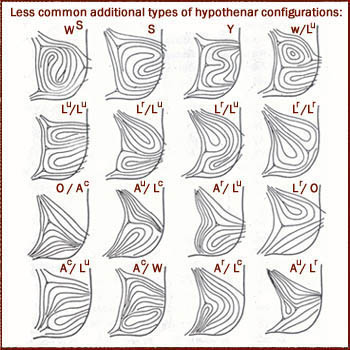
Additional dermatoglyphic hypothenar configurations - most are combinations of the basic types.
NOTICE: In the earlier mentioned German sample of 1281 males, Cummins & Midlo used this hypothenar classification system and identified the following 12 hypothenar patterns as most common - accounting for over 98% of all observed patterns in the German sample (some of their reported patterns are COMBINATIONS including two of the 12 basic patterns; V refers to 'vestige patterns'):
Au (right hand: 44.1%; left hand: 50.0%);
Au/Ac (right hand: 16.0%; left hand: 16.7%);
Lr (right hand: 15.7%; left hand: 13.6%);
Au/Lu (right hand: 4.5%; left hand: 4.6%);
Lr/Ac (right hand: 3.3%; left hand: 4.4%);
Lu (right hand: 3.0%; left hand: 2.4%);
Ac (right hand: 1.6%; left hand: 1.4%);
S (right hand: 1.6%; left hand: 0.9%);
V (right hand: 0.9%, left hand: 0.9%);
Ar (right hand: 1.5%, left hand: 0.2%);
Lr/Lr (right hand: 0.5%; left hand: 1.2%);
Lu (right hand: 0.8%; left hand: 0.5%);
Including 2 'hypothenar whorl' related patterns:
Ws (right hand: 1.4%; left hand: 0.6%);
W (right hand: 0.7%; left hand: 0.5%).
3 - THE 'HYPOTHENAR WHORL' - A COMMON FEATURE IN THE HAND OF PRIMATES!
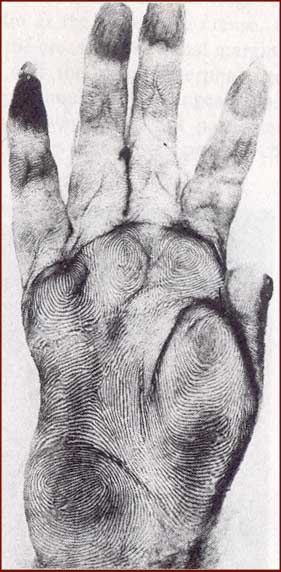
A hypothenar whorl in the right hand of a macaque (macaca fascicularis), source: 'Dermatoglyphics: an international perspective', p.58 (Mavalwala, 1978).
NOTICE: The macaque hand example above demonstrates some typical features of the primate hand, including: (1) a very short thumb; (2) a low 2D:4D finger ratio; (3) a simian line-like palmar transverse crease; and (4) various palmar whorls.
While the 'hypothenar whorl' is rare in the human hand, in the primate hand it is a common feature - the primate hand example on the right has 5 palmar whorls, including the 'hypothenar whorl'!
Primate hand examples in the work of Cummins & Midlo (1943) indicate that in primates the 'hypothenar whorl' is most common in 'promsimians' (present in 3 out of 4 example); less common in 'Old & New world monkeys' (present in 3 out of 14 examples)and least common in the 'human apes' (present in 3 out of 24 examples).
Interestingly, studies in various primate species indicate that there is a 'reversed' evolutionary link between the occurence of palmar patterns (loops and whorls) and the advance of (motoric) specialization ('Quantitative dermatoglyphics', p.98, D.Z. Loesch, 1943) - see the figure below.
Likely, this is a very important point to notice, in order to understand the 'nature' of palmar whorls!
For, this 'primate hand pattern' indicates that - next to the famous simian crease - 'palmar whorls' as well should be recognized as a potential 'problematic' hand characteristic! [Notice: in medical science the 'simian line' is recognized as a minor physical anomaly (MPA)]
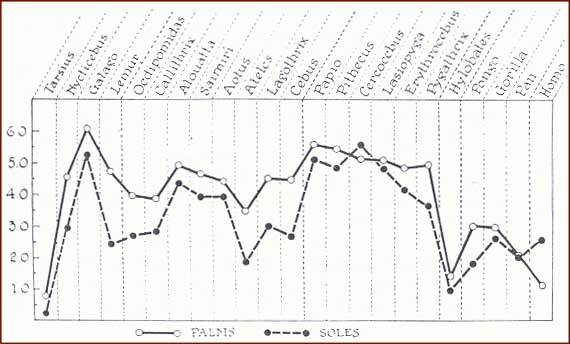
The distribution of palm & sole patterns in primates and humans, source: 'Finger prints, palms and soles', p.174 (H. Cummins & C. Midlo, 1943).
NOTICE: The primate species described in figure above are (right to left): 'Homo'=human; 'Pan'=chimanazee, 'Gorilla'=gorilla, and 'Pongo'=orangutan (the 3 'human ape' primates); the next 15 species are 'New & Old world monkeys' (starting with: 'Hylobates'=gibbon); and the last 4 primates species are known as 'prosimians' (tarsius to lemur).
4 - THE 'HYPOTHENAR WHORL' - A FEATURE OF THE DOWN SYNDROME DERMATOGRAM
While in the general population a 'true whorl' on the hypothenar is found in the hands of less than 1% percent of (normal) people, much higher percentages are being reported for people who have Down syndrome (trisomy 21) - in a French study by Ayme et.al. ('Dermatoglyphics in parents of children with trisomy 21', 1979) a percentage of 10.2% was reported for the left hand of 98 'trisomy 21 children' (6.12% for the right hand).
Dermatogram: dermatoglyphic features of Down syndrome (source: 'Dermatoglyphics in medical disorders' (1976), by: Blanka Schaumann & Milton Alter).
Typical dermatoglyphics of Down syndrome include:
5 - THE 'HYPOTHENAR WHORL' - ASSOCIATIONS WITH OTHER MEDICAL PROBLEMS
Typical dermatoglyphics of Warkany syndrome include:
6 - NEW RESEARCH: 'HYPOTHENAR WHORLS' & AUTISM!
However, in this perspective one should be aware that Down syndrome is e.g. characterised by a high frequency of 'large hypothenar patterns' (usually 'ulnar loops') which are usually featured with a high postioned axial triradius (t"): see the dermatogram of Down syndrome below.
Chapter 2 described how the 'high axial triradius' (t") and the 'hypothenar whorl' are related.
Therefore should the signficance of the 'hypothenar whorl' in Down syndrome be understood in the perspective of the presence of the 'high axial triradius' - which is a more significant characteristic of Down syndrome: see the dermatogram of Down syndrome below.
For example, in the earlier mentioned french study by Ayme et.al. (1979) the 'high axial triradius' was found in over 82% of 98 'trisomy 21 children' (right hand: 82.65%, left hand: 84.69%) - while the controls showed much lower percentages (right hand: 12.50%; left hand: 10.83%).
Nevertheless, various studies confirmed the significance of the 'whorl on the mount of Moon' in Down syndrome - especially when the 'hypothenar whorl' is found in both hands, or combined with a large ulnar loop on the other hand!
NOTICE: Certain details in the publications (Deckers et al., 1973) indicate that the significance of the 'hypothenar whorl' in the perspective of Down syndrome is actually MUCH LOWER when this dermatoglyphic pattern is found in only one hand and when the higher axial triradius is missing in the other hand!!
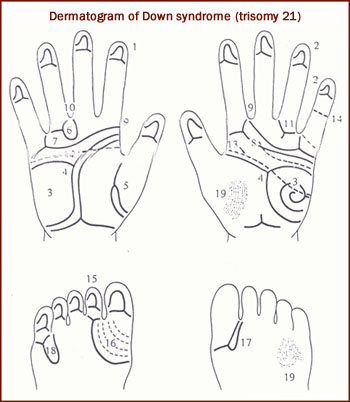
HAND:
1) Ulnar loops considerably increased in frequency, often found on all 10 fingers, loops often high and L shaped.
2) Radial loops shifted to 4th and 5th digits.
3) Large hypothenar patterns, predominantly of the ulnar type
(+ various studies reported increased frequency of whorls).
4) Distal axial triradius, high atd angle.
5) Thenar patterns (mouse of the thumb, in palmistry: 'Mount of Venus') decreased in frequency, size and complexity.
6) I3 patterns increased in frequency.
7) I4 patterns decreased in frequency.
8) Transverse alignment of main lines and ridges in the distal part of the palm.
9) D line terminating formed by a recurve of the C line.
10) I3 loop formed by a recurve of the C line.
11) Absent and abortive c lines increase by frequency.
12) Single transverse palmar creases (a.k.a. the simian line) increased by frequency.
13) Sydney lines increased in frequency.
14) Single interphalangeal crease on the 5th digit.
FOOT:
15) Fibular loops increased in frequency.
16) Arch tibial configuration in the hullucal area increased.
17) Distal loops in the hallucal are small.
18) Distal loops in area IV increased in frequency.
19) Ridge dissociation.
Quite a few studies have confirmed the significance of the 'hypothenar whorl' as a diagnostic marker:
• The 'hypothenar whorl' & schizophrenia
In probably the largest study on 'dermatoglyphics in schizophrenia' by Amrita Bagga (presented in "Application and methodological perspectives in dermatoglyphics") has described that while schizophrenics (including 592 classified schizophrenic patients [3 sub-types] + 374 'unclassified schizophrenics' were studied independently with a 210 family controls + 300 other controls) do show a tendency for having less fingerprint whorls (indicated by: higher 'Dankmeyer Index' [arches/whorls], and lower 'Furuhata Index' [whorls/loops]), the differences with control groups showed no statistically significant differences (including: patterns, ridge counts).
However, for the palm various parameters (more palmar patterns, more axial triradii, abortive C-line terminations, and more ridge dissociaton) show statistical differences with the control group.
One of the interesting findings concerns the position of the axial triradius at the hypothenar: all schizophrenia patient groups show a lower frequency of the 'normal' axial triradius position t and t'.
And all patients group show higher frequencies of the occurence of double or multiple axial triradii. The author writes (page 90):
"... It has been observed that whenever such multiplications of axial triradii occur in the palm, they are often associated with palmar patterns like loops, whorls, etc., especially on the hypothenar area."
NOTICE: So far this may sound a bit like what was described in chapter 3 for the 'hypothenar whorl' in Down syndrome.
Further parallels between the hand of schizophrenics & the hand in Down syndrome are found in a higher frequency of occurence of the simian line (though in Down syndrome the percentages are much higher).
Nevertheless, it is interesting to notice that the dermatoglyphics on the thenar (mouse of thumb, in palmistry: 'mount of Venus') provide an interesting clue. For, while the dermatogram of Down syndrome reveals that dermatoglyphic thenar patterns occur less than in 'normal population', in the hand of schizophrenics dermatoglyphic patterns on the thenar are about twice more frequently (19.78%) observed compared to the control group (8.33%)!! Bagga found a likewise parallel for I4 dermatoglyphics patterns (while in Down syndrome a lower occurence of patterns [usually loops] is found in that palmar area).
• The 'hypothenar whorl' & childhood psychosis (+ autism?)
In 1970 W.B. Hilbun published a study titled: 'Dermatoglyphic findings on a group of psychotic children' on the hands of 20 psychotic children (12 boys and 8 girls - the author suspected that some of them) - the author described that some of them might appear to be autistic. 90% Of those psychotic children had a hypothenar pattern (and 50% had a high positionded axial triradius t"). The author didn't described what hypothenar patterns were observed, but due to the very high frequency of t" occurence one could speculate about the presence of 'hypothenar whorls'.
• The 'hypothenar whorl' & Robinow syndrome (disorder on ROR2 gene on chromosome 9q22)
A syndrome that is very explicetely associated with the 'hypothenar whorl' is the Robinow syndrome - this syndrome an extremely rare genetic disorder which is characterized by short-limbed dwarfism, and various physical abnormalities.
The link between Robinow syndrome and the 'hypothenar whorl' was described by research from Turkey, by: Balci et al., titled: 'Robinow syndrome: with special emphasis on dermatoglyphics and hand malformations (split hand)'.
• The 'hypothenar whorl' & Warkany syndrome (trisomy 8)
The Warkany syndrome is often lethal at an early age, and it has an association with acute chronic leukeamia.
A dermatogram of the Warkany syndrome was presented by Blanka Schaumann & Milton Alter in their Book: 'Dermatoglyphics in medical disorders' (1976), including increased frequency of hypothenar loops and whorls.
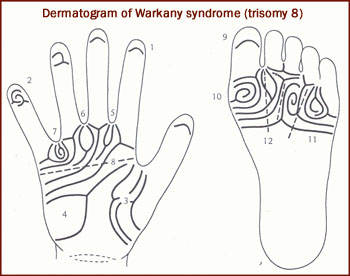
Dermatogram: dermatoglyphic features of Down syndrome (source: 'Dermatoglyphics in medical disorders' (1976), by: Blanka Schaumann & Milton Alter).
HAND:
1) Arches increased in frequency.
2) Whorls decreased in frequency but often present on the same hand together with arches.
3) Thenar patterns increased in frequency.
4) Hypothenar patterns increased in frequency (including whorls).
5) I2 patterns increased in frequency.
6) I3 patterns increased in frequency.
7) I4 patterns increased in frequency.
8) Single transverse palmar crease increased in frequency.
FOOT:
9) Arches on great toes increased in frequency.
10) Whorls in the hallucinal area increased in frequency.
11) Plantar pattern intensity considerably increased.
12) Deep furrows on palms and soles.
A study on the hands of 30 people with autism (25 men, 5 women) revealed a surprizing high percentage of a specific (very rare) variant of the 'hypothenar whorl' - the 'hypothenar composite whorl' (WS - NOTICE: Cummins & Midlo present 2 variants of this 'hypothenar whorl with a double core in the center': see the classification system that was earlier presented in this article):
• 2 out of the 25 male autistics (= 8%) have a 'hypothenar composite whorl' in the right hand (WS)*;
• 1 out of the 5 female autistics (= 20%) have a 'hypothenar composite whorl' in the right hand (WS).
* This appears to be a very significant result in the perspective that NONE of the 1281 German male had the WS hypothenar pattern in the right hand, nor the left hand (while 1.4% did have the related Ws - a 'hypothenar spiral whorl' - in their right hand; 0.8% have it in their left hand).
The picture below presents an impression from the right hand of the 3 people with autism (2 male, 1 female) that have the 'hypothenar composite whorl'.
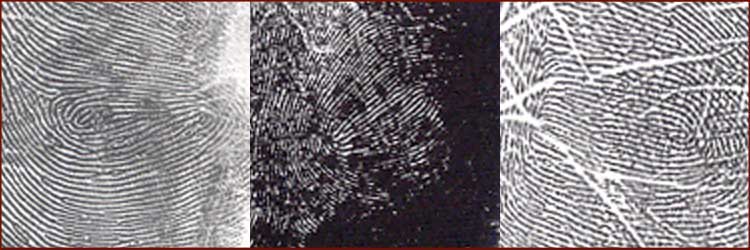
An impression from the right hand of 3 people who have autism - demonstrating a 'hypothenar composite whorl' WS.
In the perspective of this rather complex WS hypothenar pattern it is also interesting to notice that 2 other males have two hypothenar loops (one male has S on his left hand; the other male has Lr/Lu on his right hand).
Conclusion: 5 out of the 30 studied people with autism (= 16.6%) have a hypothenar pattern with 2 cores (WS, S and Lr/Lu) - which is also a remarkable high frequency in the perspective of the report for the 1281 German males.
For, this is the result when comparing the autistic males with the Cummins & Midlo report about the 1281 German males:
• 3 out of 25 male autistics (12%) have a hypothenar pattern with 2 cores in the right hand; while 4.4% of the 1281 German males have a hypothenar pattern with 'two cores' on their right hand; • 1 out of 25 male autistics (4%) has a hypothenar pattern with 2 cores in the left hand; while 3.3% of the 1281 German males have a hypothenar pattern with 'two cores' on their left hand.
• 1 out of 5 female autistics (20%) has a hypothenar pattern with 'two cores' in the right hand. • 0 out of 5 female autistics (0%) has a hypothenar pattern with 'two cores' in the left hand.

For illustration an impression of the 5 autistic handprints with 'two cores' is presented in the picture above - interestingly all 5 subjects appear to have a rather low 2D:4D finger ratio, which have been confirmed in various studies to be a marker for autism.
Measurements on the handprints indicate that all 4 males subjects have a 'digit ratio' smaller than 0.96 - which is considered as the average for males (and 2 of them appear to have a 'digit ratio' smaller than 0.92); the single female appears to have also a 'digit ratio' below 0.96 - which is well below the 0.98 average 'digit ratio' for females.
The results described in this chapter suggest that the combination of: a ''hypothenar composite whorl' + a 'low 2D:4D digit ratio' (combined with other hand characteristics that are linked with autism)... should be recognized as significant markers for autism!
NOTICE: Beryl Hutchinson writes in her book 'Your life in your hands' about the 'COMPOSITE on hypothenar' (page 124):
"The Composite or entwined loop pattern is much more difficult to help. ... The owners know they want to express something, have some gift, yet whatever they start they question themselves out of performing. This duality is one of the vital signs where recognition by hand interpretation can help beyond all reckoning. One a person understands the insistent, nagging wobble at the back of his mind he of she can use it to follow the routine of looking at all sides of a problem, sleeping on it, choosing, and only looking at the gloomy side of waht might have been. These patterns on the hypothenar I regard as of very great importance in psychiatric work for once the idea behind them is accepted they present a wonderful understanding of man."
7 - THE 'HYPOTHENAR WHORL' IN MODERN PALM READING (PALMISTRY)
Some of the hand reading experts in the Global Hand Reader Network have presented interesting contributions on the 'hypothenar whorl' (or: whorls on the mount of Moon) which refer to extraordinary styles of thinking & perception:

Hand Analyst Ed Campbell writes in his book 'Encyclopedia of Palmistry' (page 107-108):
"Like all ulnar loops, there is a practical affinity for the Moon and a tendency to follow lunar rhythms in life. A whorl in the same area is an even stronger sign of imagination and a sure sign of lunar influences. Fitzherbert believes that the subjects with a whorl on the lunar mount identify themselves with their daydreams because they appear to real. Fenton and Wright speak of the whorl on Luna as a sign of psychic gifts."
Ed Campbell's also presents a very rich & informative treatment about:
• The history of dermatoglyphics - including one comment about the 'hypothenar whorl':
"Beryl B. Hutchinson publishing in 1967 (titled: 'Your Life in Your Hands') observed ... Occasionally a whorl will be found on the hypothenar eminence (Luna) When not on the hands of schizophrenics she feels that it heightens the individuality of characteristics drawn from the subconscious. A composite found in the same area is an indication of ambivalence."

PDC Chirologist Arnold Holtzman described a theory about a specific variant of the 'hypothenar whorl' - he refers to a dermatoglyphic formation ('concentric circles on the hypothenar eminence') extending directly from the point where the lower transverse line (in palmistry 'the head line') terminates. He writes in his book titled: 'PsychoDiagnostic Chirology' (page 372):
"Each of us lives in two dimensions. The faculties of consciousness and awareness permit the anchor we have in the world of reality beyond ourselves.
The world within ourselves, largely the subconscious dimension, permits abstract conceptualizations, emotional responsiveness to stimuli originating in the first dimension, and an identification with inherent core-identity references.
The dermatoglyphic configuration that we identify as a forced focus field is a construction which overtakes the attentions and values originating in this second inner world dimension."
Read more about Holtzman's conceptualizations ('unstable fields') about the 'hypothenar whorl' at:
• Cognitive Distortions - Hypothenar Whorls

Hand Analyst Richard Unger has developed the IIHA system of 'Gift Markings in your hand' + finding life purpose in the fingerprints & dermatoglyphics. One of the life purpose markers in the IIHA-system are the '(composite) whorls and peacocks in the moon'. Unger writes in his book 'Lifeprints' (p.259):
"Whorls and peacocks in the Moon elevate this location to life-purpose status ...
... Composite whorls have the unusual quality of blinking on and off, depending on life-lesson progress. For the Moon composite, owners might shift gears seamlessly in and out of the Spiritual Teacher (the Moon Life Purpose Blossoming), like a rabbi who owns a working ranch. In the morning he counsels a family; in the afternoon he takes care of his horses; that evening he leads the prayer service. IN this example, the rabbi's life-lesson progress means that the composite whorl switches on and off without a problem. But when the life-lesson halts, the composite whorl's on/off switch becomes an uncounsious roller-coaster ride ..."

Swiss hand analyst Alice Funk is one of the very few hand analysis experts in the world who has the mysterious 'whorl on the mount of Moon' in her right hand (a sample of her 'Moon whorl' is presented with her permission in the picture below).
Jena Griffiths, a hand analyst from Switzerland has written a few words about the 'Moon whorl' in Alice Funk's hands:
"The moon whorl is the mark of a spiritual teacher or life coach, someone who is here to teach you how to access and connect with the deep intuitive or "spiritual" side of who you are.
This marker is so rare that if you have it, it overrules any other markers that show up in your fingerprints."
NOTICE: Jena Griffiths is a student at the International Institute of Hand Analysis by Richard Unger; her full article about the 'Moon whorl is available at her website: hand analysis online.
Now, after consuming all these interesting dermatoglyphic facts & figures about the 'Moon whorl'... you are invited to find the whorl in the picture below!!!
Can you find the 'Moon whorl' in this handprint?
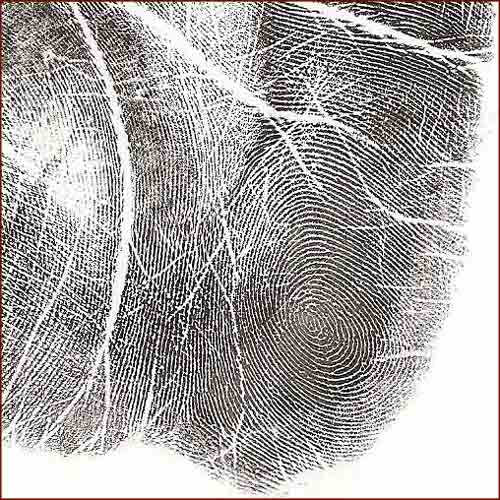
SUPPLEMENTAL NOTIFICATION:
In the history of Palmistry the 'whorl on the mount of Moon' has also been associated with a few other (questionable) issues, such as:
• thought-reading (J.S. Bright in: "Dictionary of Palmistry", p.218, 1959);
• kidney problems (M. Katakkar in: "Encyclopedic Dictionary of Palmistry", p.108, 1989).
Special thanks to Cheirologist Manfred Magg from Germany - who initiated earlier in the summer of 2009 a discussion about the 'whorl on the mount of Moon'.
SUGGESTION FOR FURTHER READING:
• The Simian Line: a notorious hand crease!
• The Sydney line: a fascinating hand mark!
• The 'whorl on mount of Moon': a mysterious dermatoglyphic marker!
Related & recommendable articles:
Dermatoglyphics: a historical review!
Fingerprints reveal more
How fingerprinting works
Fingerprints & Psychological Patterns of Personality
Medical assessment of the lines
Hand characteristics that relate to autism
The simian line (review)
The Sydney line (review)
The whorl on the mount of Moon in Down sydrome, schizophrenia & autism (review)
10 Facts about radial loop fingerprints!
10 Facts about arch fingerprints!